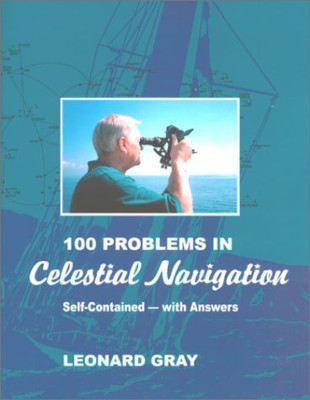
To some modern navigators the admonition: “Do not rely on a single source of navigation” means they are safe with a second GPS receiver aboard. I remember one night sailing down the East African coast, in and out of the 5-knot wandering Agulhas Current, when the U.S. Air Force shut down the GPS system. My almost total dependence on “reliable” modern navigation systems (loran, Satnav, and GPS) over the past 30 or so years had made my ancient celestial knowledge rusty. The cruise along the African coast became a very uncomfortable trip. Fortunately, I had aboard my cherished – and equally ancient – British, pre-WWII sextant of brass, silver, and ivory.
Perhaps with today’s nearly total reliance on modern navigational systems, 100 Problems in Celestial Navigation might fill an important role, rather than – as you might initially think – just stimulating the memory, or providing games for armchair sailors.
The celestial learning curve may have some sharp spikes in it when you’re trying to recapture old knowledge at the navigation table aboard a tossing sailboat at sea, with saltwater-soaked skin and only three hours sleep over the past four watches. Confidence may be lacking in the solutions. Safety may be lacking in the results.
Navigators – beginning and experienced – can enjoy fascinating voyages at home or aboard a boat in the stillness of the harbor. Gray’s second edition of 100 Problems puts you back to sea in a realistic way with problems designed to review and instruct. It gives you the vicarious enjoyment of actually being there. These are not just academic “canned” problems. The author includes “blunders” to test problems you might experience during real voyaging. He doesn’t always offer neat solutions. Problems are designed to test your judgment and ability to search for alternative clues, proving that navigation is not all science but a creative art as well.
All reference tables are included to complete the voyages presented, as is a sight reduction form for publications H.O. 249 or H.O. 229. Furthermore, an appendix includes a review of procedures for all the necessary methods. After completing just a few of the 19 book voyages, both the pollywog and shellback should navigate comfortably by celestial spheres with newfound confidence.
I found this book to be a refreshing approach to the study of celestial navigation. It removes the typical pedantic study and adds stimulating, imaginative adventure. The beginner learning celestial navigation will experience the problems of voyaging across the equator or international date line, and the “old pro” might be reminded of former voyages. The reader/navigator can never get lost. The answers are in the appendix – not so at sea, unfortunately.
100 Problems in Celestial Navigation; Self-Contained-with Answers by Leonard Gray (Paradise Cay Publications and Celestaire, Inc; 1999; 168 pages)




